Given its rapid, widespread adoption in just about every industry, it’s no surprise that AI is turning the world of PPC on its head, too.
Unfortunately, AI-powered ‘black box’ ad types (e.g. AI Max), new AI search tools (e.g. SearchGPT and Google’s AI Mode), and an increasingly AI-powered legacy search experience (looking at you, AI Overviews) means that marketers are largely feeling at the mercy of AI, rather than in control of it.
But some marketers - such as Frederick Vallaeys - are using AI to empower their marketing efforts, and save thousands of hours (and therefore dollars) through the strategic use of AI in PPC.
To help other marketers follow the same path, we hosted a live session with Fred, where he revealed his key insights on using LLMs (large language models - such as ChatGPT) to streamline and scale PPC efforts.
Fred was recently voted the #1 most influential PPC expert by PPCsurvey.com after sharing his decades of experience with others in the PPC industry. He even helped shape PPC itself, spending a decade as a Product Specialist / Ads Evangelist at Google, before becoming the Cofounder and CEO at Optmyzr - a company that specializes in making PPC teams more effective and efficient.
Watch the full session with Fred here - or keep reading for the written rundown:
Timestamps:
0:00 - Intro & Fred’s interview with Ginny Marvin
2:04 - PerformanceMCR
5:12 - GML2025 discussion (Icebreaker poll)
9:05 - Session agenda
13:08 - Comparing LLMs
19:02 - How to craft better prompts
27:08 - Adriaan Dekker’s prompt example
28:15 - Key PPC & AI experts to learn from
29:06 - Fred’s take on Cursor, v0.dev, etc.
36:25 - How to connect ads data to GenAI
42:11 - The next phase of GenAI for PPC
45:55 - Key pitfalls & risks to be aware of
49:39 - How LLMs & AI are fueling bot traffic
51:05 - How to negate AI-powered bot traffic
53:38 - Q&A with Fred Vallaeys
1:05:40 - Wrapping up
Comparing LLMs for use in PPC
LLMs are evolving so fast that chasing "the best" one can feel like a moving target.
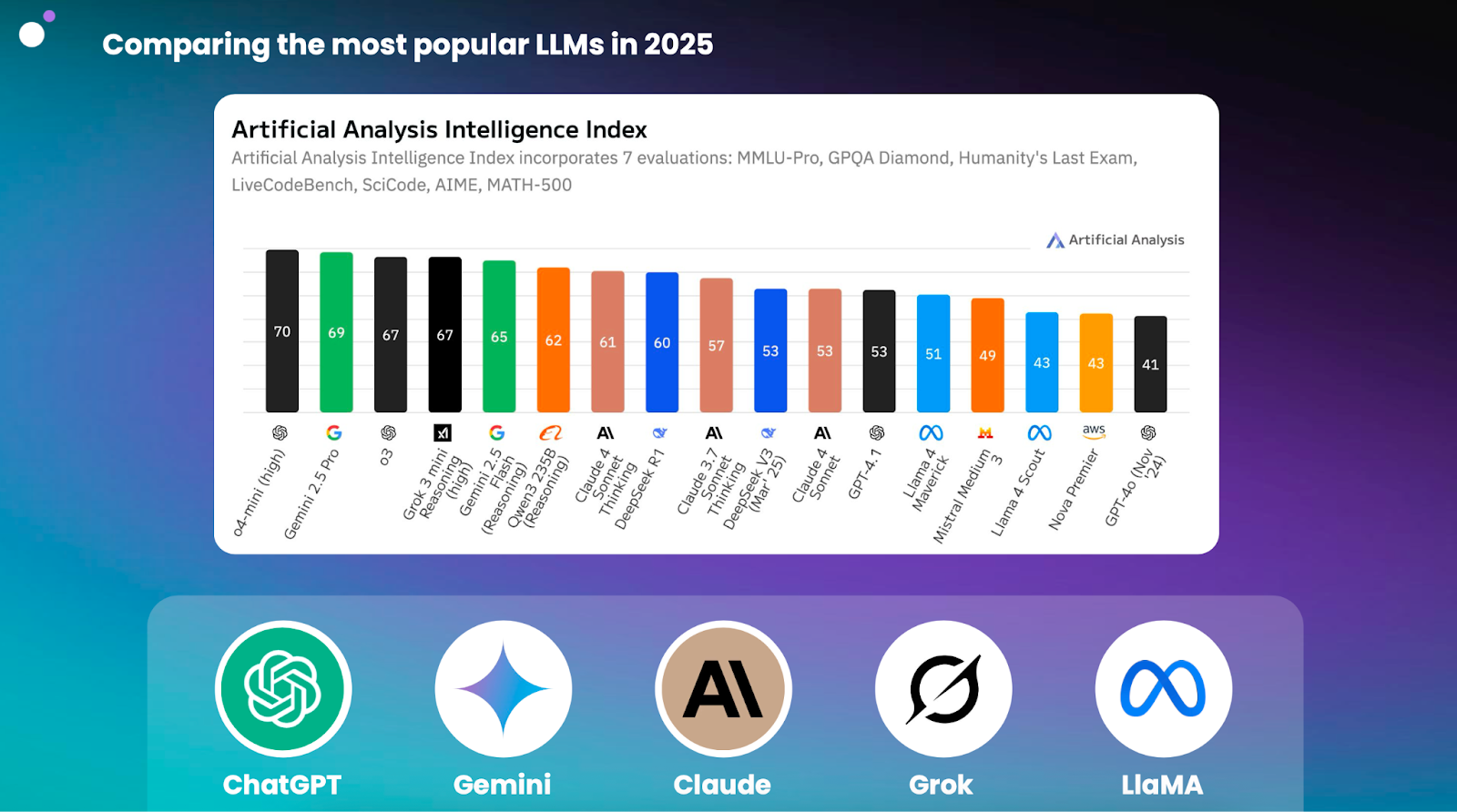
As Fred explained, benchmarking changes almost daily. Instead of obsessing over leaderboards, he recommends focusing on what’s good enough for the task at hand. For example:
- For simple keyword generation or ad copy ideas, older or cheaper models often work perfectly fine - if you give it the right prompts (more on that later).
- For more advanced work like seasonality analysis or complex reporting, it may be worth paying for a more capable model.
Cost also matters. When scaling LLM usage via APIs for internal tools, cheaper models with comparable accuracy can deliver massive savings.
Key takeaway: Don’t be fooled by benchmarks, rankings, or flashy features. Prioritise fit-for-purpose over latest-and-greatest.
How to craft better prompts
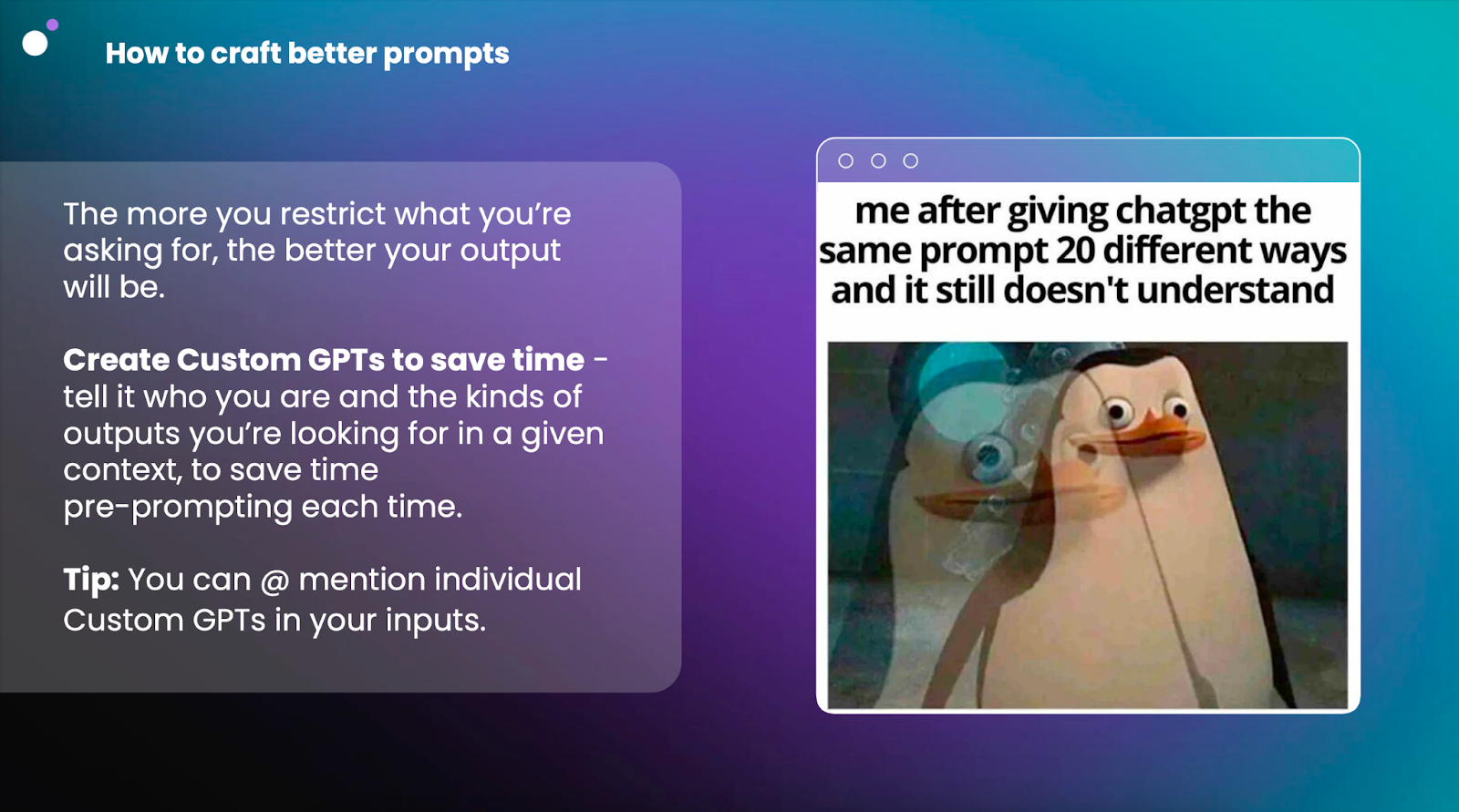
Cast your mind back to 2022, when ChatGPT really started taking off. All of a sudden, thousands of self-proclaimed ‘prompt engineers’ started appearing out of nowhere, with some demanding three-figure salaries to type a few sentences into an LLM and call it a day.
Nowadays, prompt engineering isn’t just hype - it really matters. As Fred put it:
“An LLM is like the smartest person in the world, but if your question is too vague, it may go off in the wrong direction.”
In order to keep things on track,
- Get very specific about what you want.
- Restrict the scope of the response (e.g. “tell me about Java the island, not Java the programming language”).
- Layer your prompts: start broad, refine, then give the model an optimised version.

Fred also shared a practical technique: use an initial prompt to help generate a better version of itself.
As an example, if you start with "make me a funny cat video," the model can help you think through key details (cat type, setting, tone) before you run the final generation.
Another tip: many AI engineers at OpenAI use incredibly long prompts when building tools. The same principle applies here - the more detailed the prompt, the better the result.
"A 10,000-word prompt to do code building is not unusual. The better you can describe what it is you want, the better the outcome."
Key takeaway: The more detail and boundaries you give, the better the output.
Adriaan Dekker’s prompt example
Adriaan Dekker, another influential leader in PPC & AI, provided a great example of how granular an effective prompt should be. His template (shared in the webinar’s resource list below) walks through:
- Campaign goal
- Audience context
- Tone of voice
- Style and formatting guidelines
- What to avoid
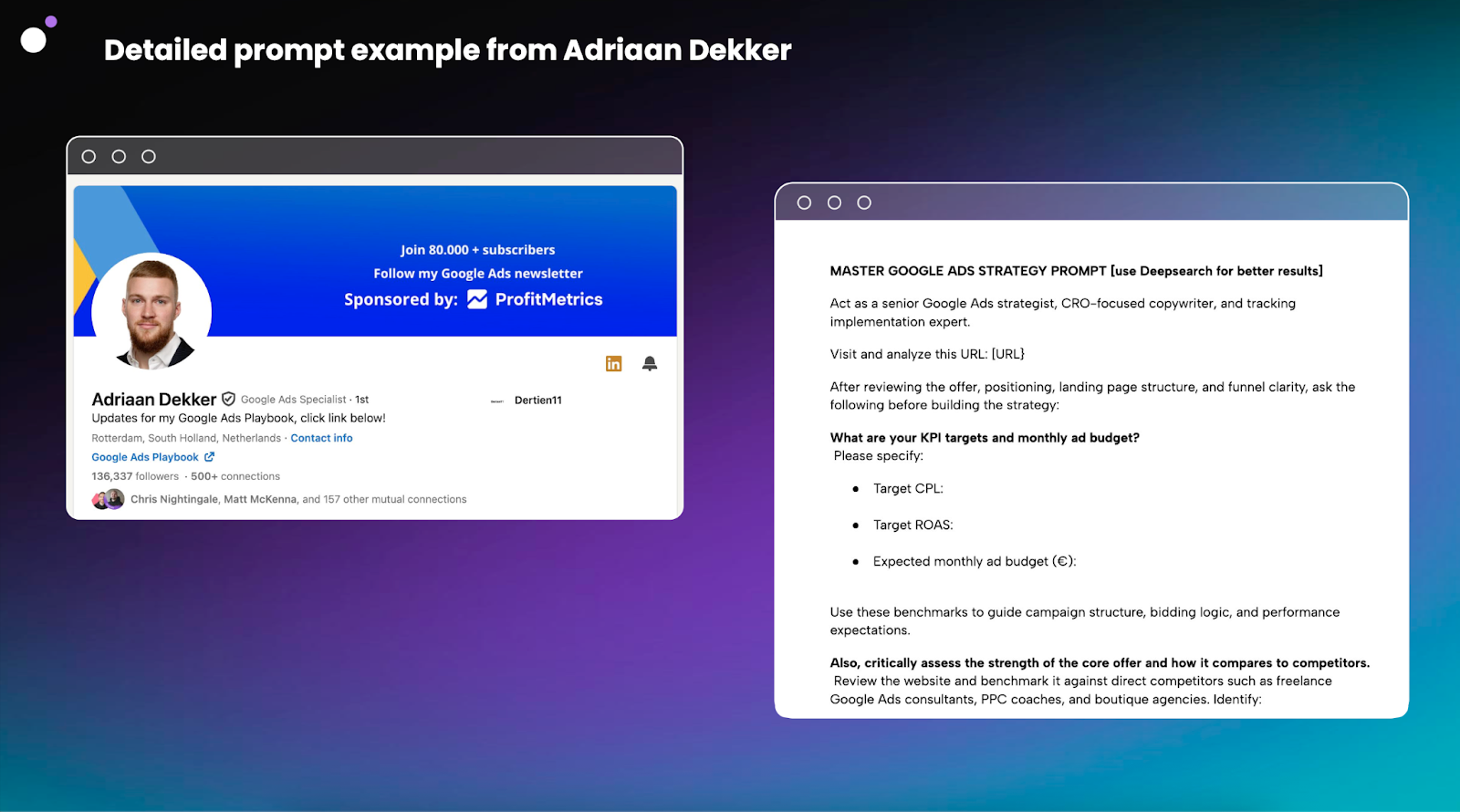
It’s not a silver bullet - but it is a helpful framework to adapt and build your own reliable prompting structures.
Key takeaway: Detailed, structured prompting is essential - don’t rely on vague instructions.
Key resources from the session:
Before we continue recapping Fred’s GenAI insights, tips, and practical strategies, here’s the key resources mentioned throughout the session that can help you drive GenAI & PPC performance:
- GML 2025 Recap - Fred & Ginny Marvin - Fred interviewed Ginny Marvin on the key announcements from GML 2025 (featuring an excellent segway intro)
- Fred on the Paid Media Lab podcast - For more on using AI in PPC to its full potential, check out Fred's episode of the Paid Media Lab
- LLM Comparison Matrix - Artificial Analysis - A detailed comparison of the available LLMs to inform your strategy
- Crafting the perfect ChatGPT prompt - Charlene Li - Additional guidance on crafting the perfect prompts
- Amy Hebdon’s 17 strategic ChatGPT prompts for PPC - Amy Hebdon’s key prompt examples to streamline PPC workflows
- Reddit prompt to get ChatGPT to engineer inputs - Get ChatGPT to engineer its own prompts!
- Adriaan Dekker prompt example - Google Ads Strategy - Link to Adriaan Dekker’s prompt example (mentioned above)
- Cursor - AI Code Editor - Mentioned in the session, cursor uses AI to seriously speed up the coding process
- v0.dev - 6 Surprising Things You Can Do With It - 6 great use cases for Fred’s preferred AI coding tool, v0.dev
- 7 free Google Ads scripts - Marc Cornelius - Some really useful Google Ads scripts to improve workflows
- How to build an AI agent (no coding) - Alfred Simon - Guide on building a custom AI agent, without coding
- Fred’s SEL article - How to connect ads data to GenAI - Fred’s in-depth Search Engine Land guide on connecting ad data to GenAI
- Optmyzr Sidekick - learn more - A tool that helps advertisers get more from their ad accounts
- Imperva Bat Bot Report 2025 - What you need to know about AI bot traffic in 2025
- The hidden cost of AI scraping - Design Rush - Get up to speed on AI scraping, and learn how much it could be costing you
- Lunio case study - Graff Jewelry - How Graff used Lunio to cut IVT by over 40%
Key PPC & AI experts to learn from
If you’re serious about using AI to its full potential in PPC, there are some who are on top of the PPC/GenAI game right now that you’ll want to learn from.
Besides Frederick himself, four other experts were mentioned throughout the session. With AI evolving as fast as it is, following certified experts in the field is a great way to help you stay ahead of the curve:
- Follow Fred on LinkedIn - you’re likely doing this already - but in case you’re not, make sure to follow Fred on LinkedIn for key PPC/AI updates and insights.
- Mark Cornelius - Created multiple helpful Google Ads scripts with ChatGPT.
- Alfred Simon - Builds innovative AI agents for PPC workflows.
- Adriaan Dekker - Shares in-depth analysis and practical LLM applications for PPC.
- Geert Groot - Shares Cursor templates & other practical LLM resources
How to connect ads data to GenAI
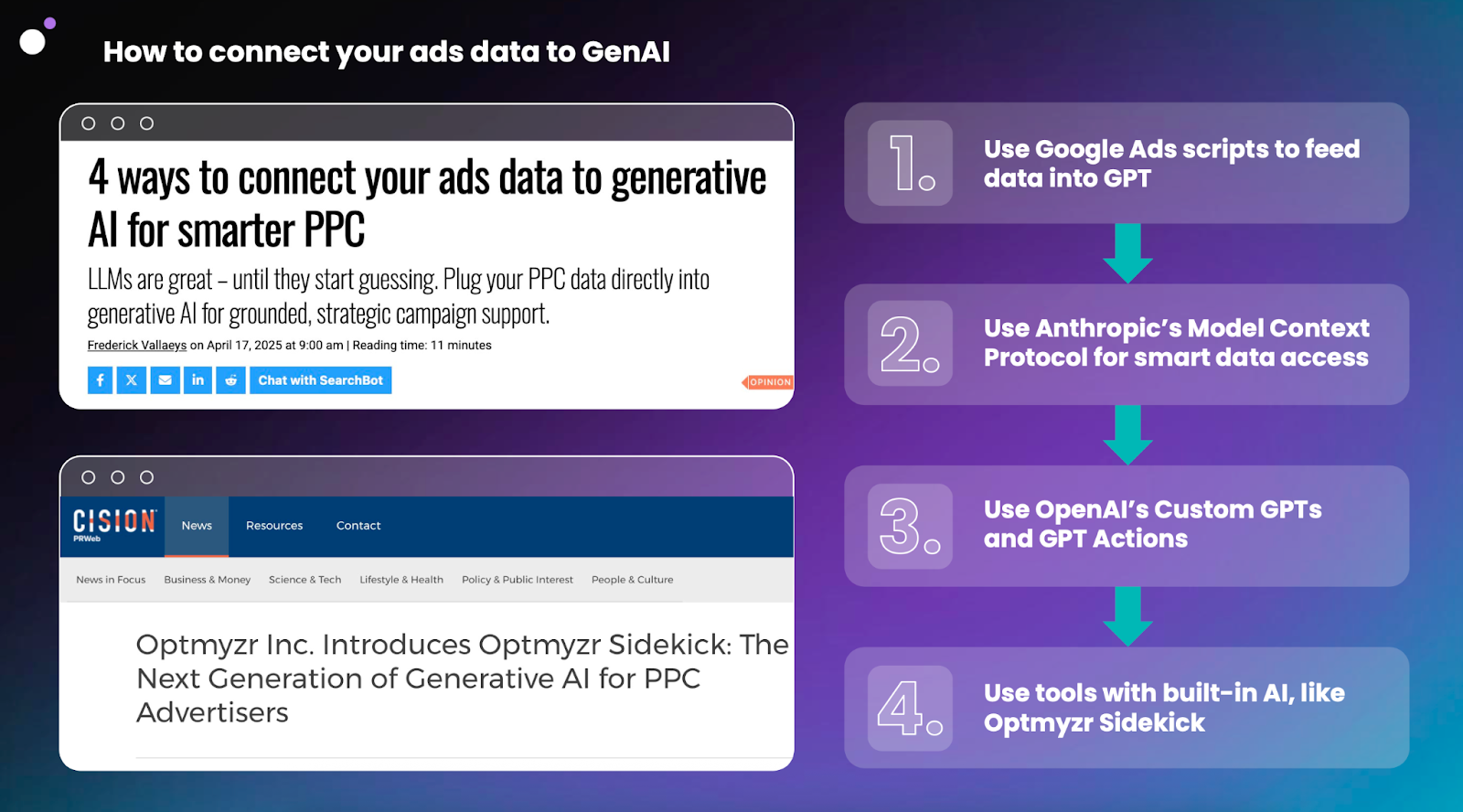
Fred outlined four main ways to ground LLMs in your actual PPC data (crucial to avoid hallucinations):
1. Manual copy/paste
The simplest starting point is to download your Google Ads reports (such as a search terms report) as CSV files, then paste them directly into the LLM as part of your prompt. While this works for smaller datasets, it quickly hits practical limits with larger or more complex data.
2. Google Ads scripts with API calls
A much more scalable approach is to use Google Ads scripts. Fred has written scripts that pull data directly from your Google Ads account and send it via API to an LLM (such as OpenAI's API). This enables automated reporting, insights generation, and optimisation suggestions directly from live data.
3. Custom GPTs with actions (API integrations)
For more advanced use cases, you can build Custom GPTs with API actions. This lets the GPT query your data sources in real time. For example, a GPT could call the Google Ads API to pull current campaign metrics, then combine that with other systems (like Optimyzr or CRM data) to provide more intelligent recommendations.
Fred compared this to systems like OpenTable, where an AI agent can not only suggest a restaurant but also check table availability and make a booking - because it’s connected to the backend via an API.
4. Built-in capabilities of tools like Optmyzr
Finally, some SaaS tools are now embedding GenAI capabilities directly into their platforms. Fred’s own platform, Optmyzr, is adding features that let users leverage AI-driven insights and recommendations without having to build their own integrations.
Fred emphasised that grounding is absolutely essential:
"LLMs are going to make stuff up. They are going to hallucinate. And when it comes to ads data or SEO data, that's a particular problem. We're talking about actual money for actual clients, and we can't just have stuff made up."
Key takeaway: To safely use GenAI for optimisation, it must be grounded in real data. Start simple, but explore more advanced integrations as your use cases evolve.
The next phase of GenAI for PPC
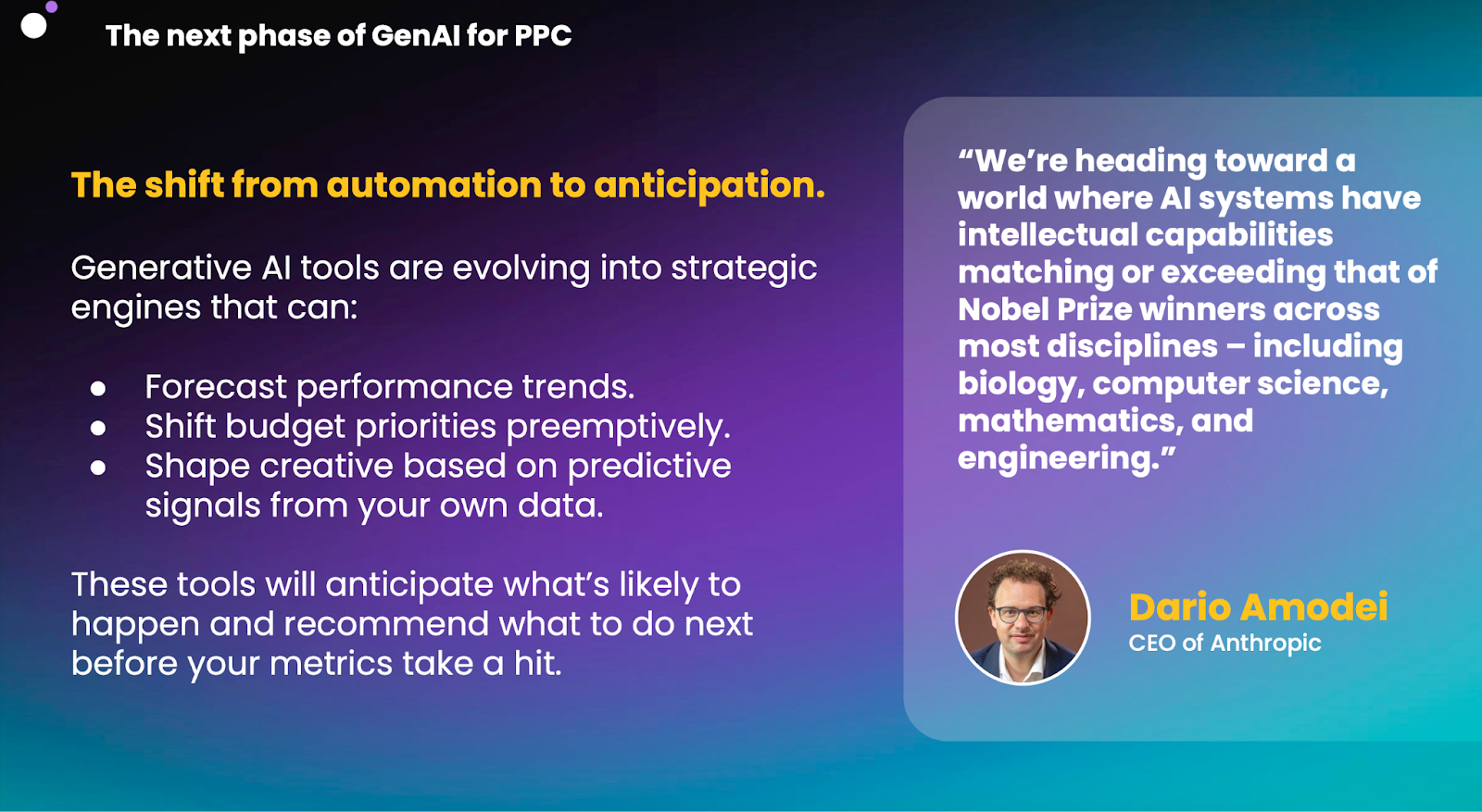
We’re moving from automation to anticipation. Fred referenced Anthropic’s vision of proactive agents that:
- Stay on top of your tasks continuously.
- Coordinate between multiple assistants.
- Proactively surface optimization opportunities.
Fred explained this shift by saying:
"Instead of us sitting at a computer issuing one prompt at a time, it’s more like having an AI assistant who’s constantly aware of the context of your campaigns, continuously monitoring performance, and suggesting or even initiating optimisations proactively."
He also shared that agents could soon coordinate across platforms and tools. For example:
- One agent might monitor search term trends.
- Another might analyse conversion data.
- A third could compare performance across channels.
These agents could collaborate and surface actionable recommendations without the marketer needing to manually pull data from multiple sources.
"Imagine having a team of 1,000 virtual assistants, each specialised in one small area of optimisation, all working together to improve your account every single day."
Fred expanded on this in his episode of the Paid Media Lab podcast, which you can watch (or get the written takeaways) here.
Key takeaway: We’re heading towards agents that act more like proactive assistants than reactive tools, continuously driving incremental gains.
Key pitfalls & risks to be aware of when using GenAI for PPC
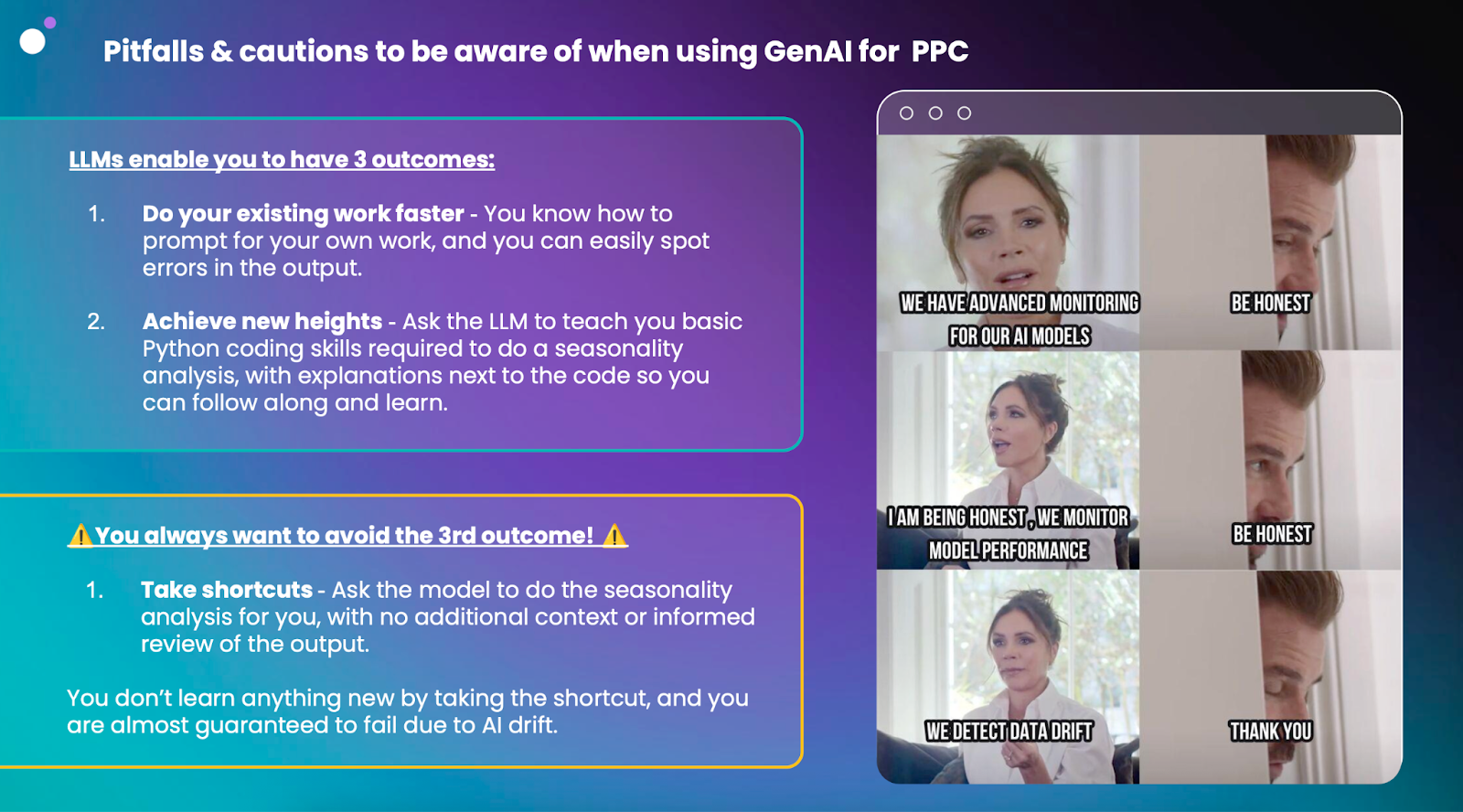
Fred outlined the three types of LLM usage:
- To speed up tasks you already know how to do
- Low risk, as you can easily spot errors and judge the quality of the output because it’s a task you’re already experienced in.
- To learn new things and scale new heights
- Useful if you remain curious and validate outputs. For example, using an LLM to assist with statistical analysis or to write Python scripts - but only if you’re actively questioning and checking what the model is doing.
- To shortcut tasks you don’t understand
- If you blindly copy outputs for tasks you can’t evaluate, you’re asking for trouble. As Fred put it:
"If you’re asking GPT to do a seasonality analysis for your boss and you’ve never done one yourself, you won’t know if it’s giving you nonsense. That’s when people get fired."
Fred also warned about two technical risks:
- Hallucinations: LLMs can invent information or misinterpret patterns if not properly grounded.
- Drift: Even deterministic prompts can give subtly different answers over time. For any critical output (e.g. calculations, regulatory reporting), it’s vital to save and reuse validated code rather than re-running the same prompt repeatedly.
"Day over day, the frequency of LLMs being correct is actually going to change"
In addition, there’s a broader risk of misplaced trust: over-relying on AI can lead to complacency. As Fred emphasised throughout the session, human oversight remains essential - especially in PPC, where mistakes can directly impact spend and client results.
Key takeaway: AI should augment your expertise, not replace it. Use it to go faster and expand your capabilities, but always stay in control and validate key outputs.
How LLMs & AI are fueling bot traffic
Imperva’s 2025 Bad Bot Report shows that AI scraping and bot activity is now driving 51%+ of all web traffic.
- Bad bots (malicious, fraudulent) are growing year on year.
- AI scrapers (training LLMs) contribute significantly to this trend.
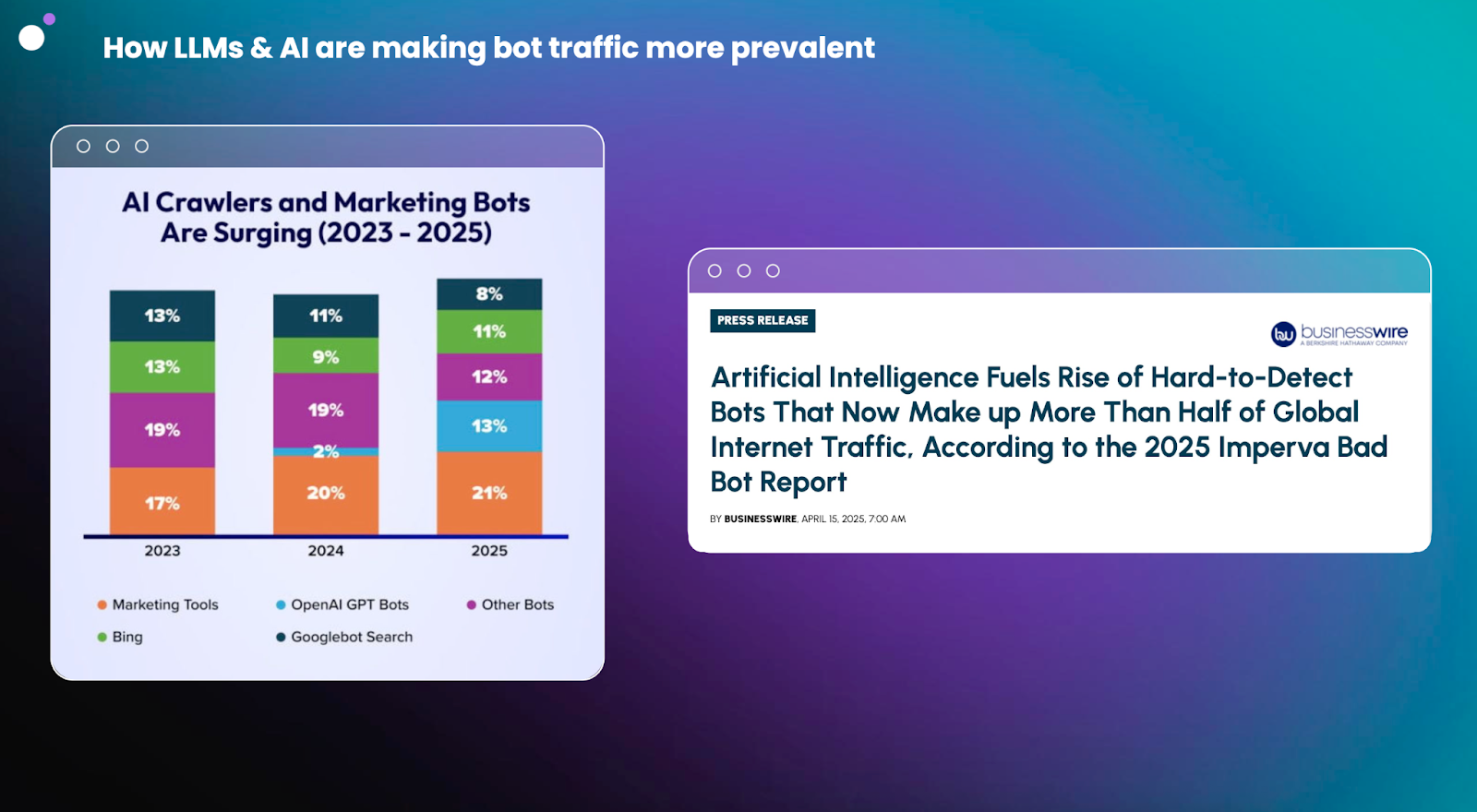
This surge is increasing the amount of invalid and non-human traffic reaching paid campaigns, with AI-driven bot activity becoming one of the fastest growing sources of ad waste.
Key takeaway: Bot traffic is growing - both in number, and in complexity. If you’re not protecting yourself from advanced bot traffic, you’re likely losing significant portions of your ad budget.
How to negate AI-powered bot traffic
Ad spend protection is more important than ever.
- AI bots can inflate click volumes.
- Fake leads and spam form fills are on the rise.
- Seasonal peaks (Black Friday, etc.) see huge bot surges.
Using Lunio, Graff, a global leader in luxury jewelry, experienced over 40% less invalid traffic than the unprotected average on Google alone - resulting in significant savings which could then be re-invested back into ad campaigns.

If you’re not already monitoring your invalid traffic rates, now is the time to start. AI-fueled bots aren’t going away - they’re multiplying at a significant rate.
Key takeaway: Active protection against AI-driven invalid traffic is now a must-have. Get a free 14-day traffic audit to see how much of your traffic is invalid.
Final thoughts
AI is changing PPC at a breakneck pace. But with the right approach, it can be an opportunity - not a threat.
As Fred put it:
“We have to be ready for a sea change in how we connect buyers and sellers. The old ways are dying. But new ways are emerging, and marketers who adapt will still have a huge role to play.”
By combining:
- The right LLM choices
- Strong prompt discipline
- Grounded, data-driven workflows
- A clear-eyed view of risks
- Ongoing protection against invalid traffic
Performance marketers can harness GenAI to deliver better results, faster.
And as Fred’s examples showed, many of the most powerful applications start with small experiments. If the idea of revamping your PPC workflows seems overwhelming at first, pick one idea from this recap, test it, and build from there.
Big thanks to Frederick Vallaeys for joining the session, and for sharing his cutting-edge insights with us.
Watch Fred’s episode of the Paid Media Lab for additional context and insights on using AI in PPC - and check out the key resources section earlier in the recap for additional content, tools, tips, and insights to help you get started.



